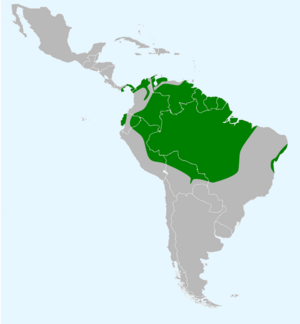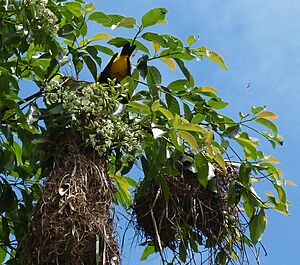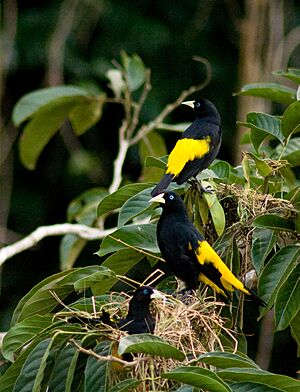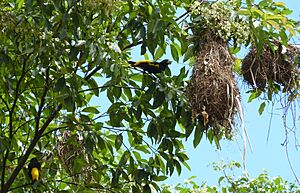Yellow-rumped cacique facts for kids
Quick facts for kids Yellow-rumped cacique |
|
|---|---|
 |
|
| in Brazil | |
| Conservation status | |
| Scientific classification | |
| Genus: |
Cacicus
|
| Species: |
cela
|
 |
|
| Global range (green) | |
| Synonyms | |
|
|
The yellow-rumped cacique (Cacicus cela) is a striking black bird with bright yellow patches. It belongs to the passerine group, which are often called "perching birds." These birds live in the New World (North and South America). You can find them breeding across much of northern South America. Their range stretches from Panama and Trinidad south to Peru, Bolivia, and central Brazil. They have even been seen as far north as Nayarit state in Mexico.
Contents
About the Yellow-rumped Cacique
What Does It Look Like?
The yellow-rumped cacique is a slim bird with a long tail. It has bright blue eyes and a pale yellow, pointed bill. Most of its plumage (feathers) is black. However, it has a bright yellow rump (the area above its tail), the base of its tail, its lower belly, and yellow "epaulets" on its wings.
Male caciques are usually about 28 centimeters (11 inches) long. They weigh around 104 grams (3.7 ounces). Females are a bit smaller, about 23 centimeters (9 inches) long and weighing about 60 grams (2.1 ounces). The female's black feathers are not as shiny as the male's. Young birds look like females but have dark eyes and a brownish bill.
What Do They Sound Like?
The male yellow-rumped cacique has an amazing song! It's a mix of clear, fluting (like a flute) notes, cackles, and wheezes. Sometimes, they even copy sounds they hear from other birds or animals. They also make many different calls. When a group of these birds is active, you can hear them from far away!
Where Do They Live?
Yellow-rumped caciques like to live in open woodlands. They also enjoy areas where people have cleared land for farming, as long as there are still large trees around.
What Do They Eat?
These birds are very social and often live in groups. They eat a variety of foods, including large insects. Their diet includes beetles, caterpillars, crickets, grasshoppers, and katydids. They also enjoy spiders, like orb-weavers. Besides insects, they drink nectar from flowers and eat fruit, such as chupa-chupa and figs.
How Do They Reproduce?
Yellow-rumped caciques are "colonial breeders." This means many pairs build their nests close together in one area, often in the same tree. You might see up to 100 bag-shaped nests hanging from one tree! These trees often have active wasp nests too. The caciques seem to like building near wasps, as it might help protect their nests from predators.
Only the females build the nests, sit on the eggs (this is called incubating), and take care of the young birds. Each nest is like a long bag, about 30–45 centimeters (12–18 inches) long. It gets wider at the bottom and hangs down from the end of a tree branch. Female birds will compete to get the best spots for their nests, especially those closest to the wasp nests for protection.
A female usually lays two eggs. These eggs are pale blue or white with dark spots. She starts incubating after she lays the second egg. The eggs hatch after about 13 or 14 days. The young birds stay in the nest for 34 to 40 days before they are ready to fly (this is called fledging). Usually, only one young bird survives and leaves each nest.
Caciques and People
The yellow-rumped cacique has actually benefited from changes made by humans. When forests are cleared for farms and ranches, it creates more open areas that these birds like. Because of this, the IUCN (International Union for Conservation of Nature) does not consider this bird to be in danger.
In Peruvian folklore (old stories and beliefs), this bird is often called paucar. Specifically, the yellow-rumped cacique is called paucarcillo which means "little paucar." There's a folktale from Moyobamba about this bird. The story says that the paucar bird was once a boy who loved to spread rumors. He always wore black pants and a yellow jacket. One day, he spread a false story about an old woman who was actually a fairy in disguise. The fairy then turned him into a noisy, wandering bird. People believe that seeing this bird brings good news.






